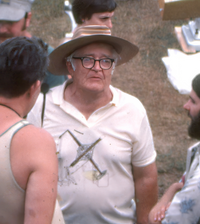Walter Scott Houston
| Walter Scott Houston | |
|---|---|

Walter Scott Houston at the 1983 Stellafane convention
|
|
| Born |
May 30, 1912 Tippecanoe, Wisconsin |
| Died | December 23, 1993 (aged 81) Cancún, Mexico |
| Residence | East Haddam, Connecticut |
| Nationality | American |
| Alma mater | University of Wisconsin |
| Occupation | English teacher, editor |
| Employer | American Education Publications |
Walter Scott Houston (May 30, 1912–December 23, 1993) was an American popularizer of amateur astronomy. He wrote the "Deep-Sky Wonders" column in Sky and Telescope magazine from 1946 to 1993.
Houston was born in Tippecanoe, Wisconsin in 1912. He attended the University of Wisconsin where he earned a degree in English. After graduating, he taught at universities and public schools in Wisconsin, Ohio, Alabama, Kansas, Missouri and Connecticut. During World War II he was an instructor at the Advanced Navigation School for Army-Air Force pilots at Selman Field in Louisiana. In 1960 he moved to Connecticut where he became an editor for American Education Publications. He remained in this position until his retirement in 1974.
As a boy, Houston learned to build microscopes and telescopes and developed an interest in amateur astronomy. He soon observed all 103 nebulae and star clusters in the Messier catalog. While at the University of Wisconsin he began observing variable stars and in 1931 he joined the American Association of Variable Star Observers (AAVSO). Eventually, he contributed more than 12,000 variable star observations to AAVSO.
While living in Kansas in the 1950s, Houston undertook radio monitoring of meteor activity. His group operated the first automated data collection system designed by amateurs for continuous, long-term collection of meteor event data. The same method forms the basis for most forward scatter automated detection systems used today, although other methods are available.
In 1955, Houston recruited a few dozen people as satellite spotters for Operation Moonwatch. In 1958, his Moonwatch station in Manhattan, Kansas was the first to catch sight of Explorer I, the United States' first satellite.
Houston was active in raising funds for the project, by giving talks about satellite watching and asking for contributions. He was so successful that the president of Kansas State University included Houston's team in his annual science research summary, and the Physics Department donated equipment to the group.
...
Wikipedia
